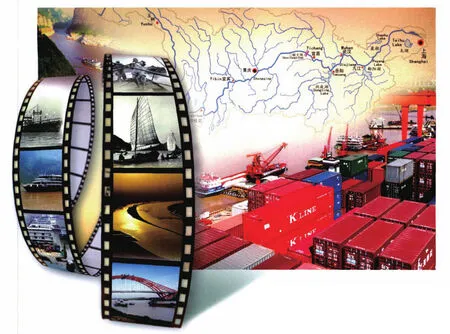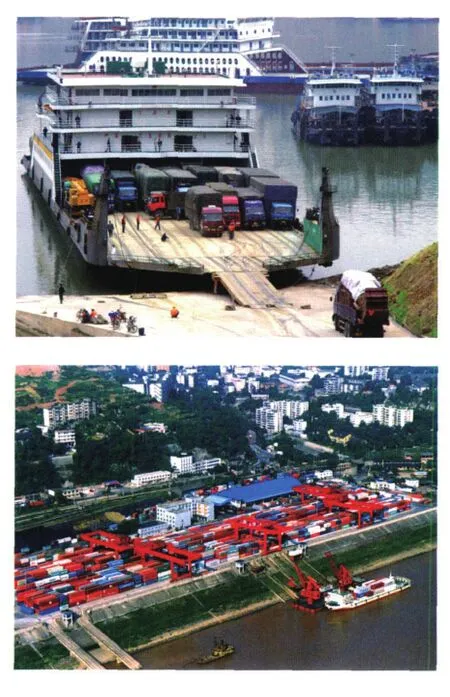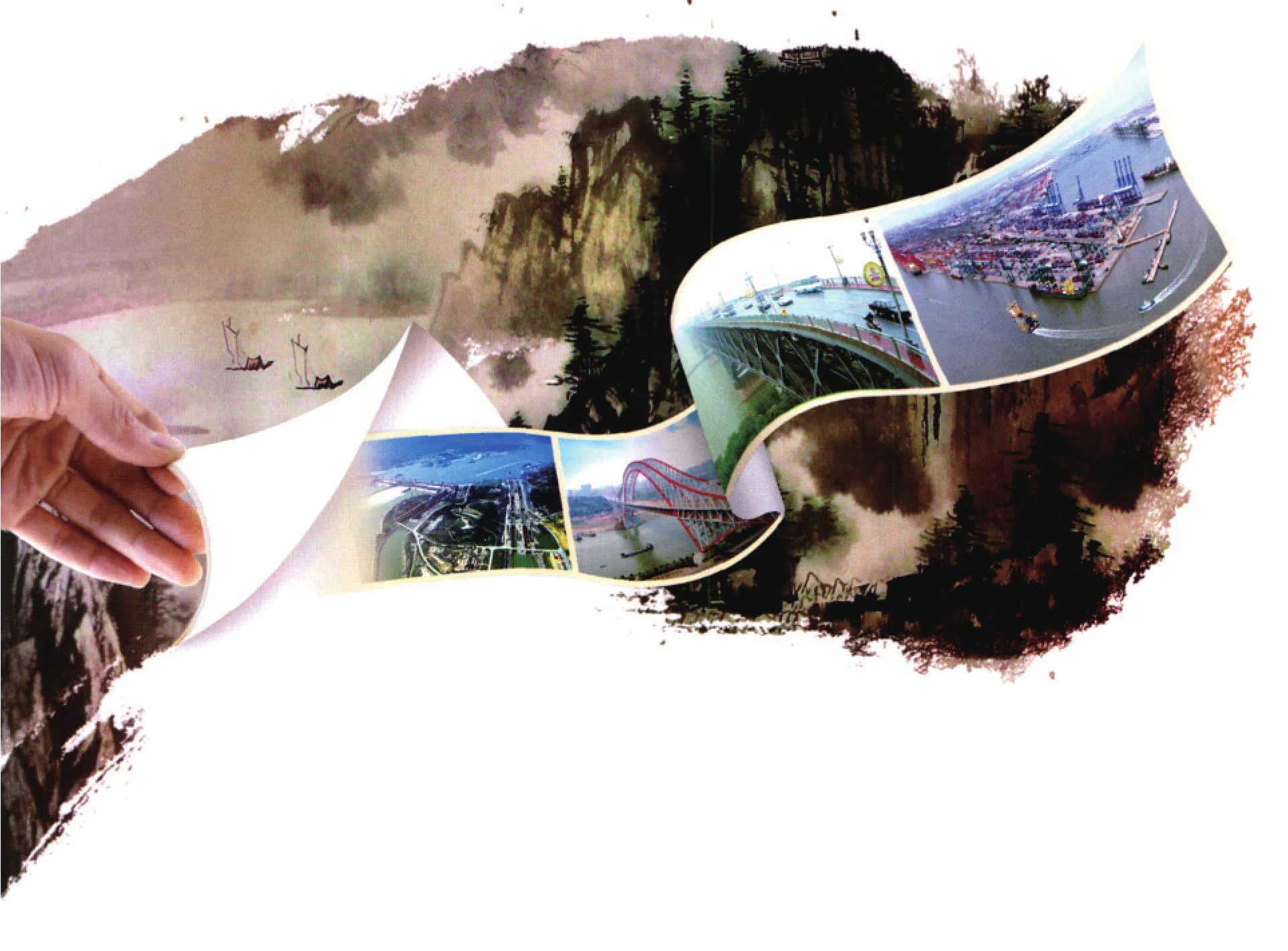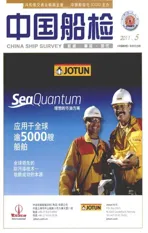长江航运变迁
2011-05-26
本刊记者 徐 华
长江航运变迁
本刊记者 徐 华
“君住长江头,我住长江尾,日日思君不见君,共饮长江水。”自古以来,长江就承载了古人的万千情思,从巫山风雨到秦淮灯影,大江流经之处,无不摇曳着行船者的漂泊与期盼。伴随着世事变迁,千年长江航运经历着沧桑巨变。

流淌千年的繁荣
7000年前的新石器时期,独木舟开启了长江的原始航程,由此长江航运的起源初定,至东汉木帆船广泛航行于长江之中。到了唐代,长江成为全国通航里程最长、货运量最大的河流,“蜀麻吴盐自古通,万斛之舟行若风”,生动地再现了当时长江水运的兴盛景象。而享受长江水运之利的人们,则有“朝辞白帝彩云间,千里江陵一日还”,“逆风上水万斛重,齐声腾踏千船歌”的愉悦。在其他交通运输方式尚未形成和极其落后的社会时期,横贯中华大地,畅达大江南北的长江航运,以其舟辑之利服务于当时的军事、政治和经济,船舶成为人们社会生活中不可缺少的重要交通工具。
近代长江航运,在压迫下求生存,在抗争中求发展,长江民族航运业自强不息,在与列强资本的斗争中奋起。靠一艘小火轮起家的民生公司,发展成为川江实力最雄厚的民营航运企业,也是近代中国规模最大的民族资本航运实体。1873年,轮船招商局在上海成立,作为中国第一个官督商办企业,它的问世,标志着中国开始了从农业社会向工商业社会的演进。1873年7月,中国商轮首次航行在中国内河,招商局旗下的“永宁”号从上海开航,溯江而上,至镇江、九江、汉口,中国近代内河航运业第一次融入国际经济大循环。招商局和民生公司的崛起,成为了近代长江航运业新兴和发展的杰出代表。
新中国成立后,长江干线航道满目疮痍,令人扼腕痛惜,运输船舶技术状况普遍较差,且大都是老旧、木质小船,港口设施极端落后,航道完全处于天然状态,上游礁石林立,中下游浅滩密布,助航设施简陋,航道通过能力低下,大部分河段不能夜航,航运安全和航运效益都无法得到保障。然而,在沿江铁路、公路极其落后的情况下,为巩固新生的人民政权,支援全国解放和抗美援朝战争,保障人民生活安宁,长江航运再一次发挥了其无可替代的功能。建设码头,修造船舶,清除沉船水雷,爆破暗礁,治理航道,改进运输生产组织,使饱受战争创伤的长江航运迅速恢复生产,运输能力不断提高,发挥了交通大动脉的作用,立下了不可磨灭的功勋。长江航运从此走上了一条由天然河流到黄金水道的发展道路。
默默无闻的挖掘
新中国成立伊始,长江航运成为当时的主要运输通道。刚获新生的长江航运,集运数百万吨粮食及军用物资,组织公、私营轮船和民船,支援中国人民解放军继续南下,完成了解放大西南、海南以及抗美援朝的支前运输任务。国民经济三年恢复时期,长江客货运输又在川粮东运和支援成渝铁路建设,活跃城市经济,平抑物价,促进国民经济恢复和发展中起到了重要作用。特别是1952年,长江航运提前一个月完成荆江分洪工程所需的几十万吨的器材物资运输,被荆江分洪指挥部特予通令表扬,誉为新中国航运事业上的创举。从1952年开始的长江干线一列式拖驳运输,到1978年推行的分节驳顶推运输,到80年代初不断发展的集装箱运输,长江航运在曲折中前进。然而,此时的航道整治处于起步阶段,长江航运依然要靠天吃饭。
1953年初,第一个炸礁工程在观音滩、蚕背梁开工,打响了川江航道整治的第一炮;紧接着戴家洲直港工程启动,开启了长江中下游航道整治的历史。从上世纪50年代起,我国开始对长江干线航道分阶段、有步骤地整治建设。到“九五”期前,国家重点对上游航道进行了系统治理,共整治滩险123处,零星清障115处,航道通过能力提高8倍以上,千里川江逐步摆脱天然状态。
1963年至1965年,在国家进行经济体制改革、试办托拉斯的过程中,长江航运是全国试办托拉斯的12个试点单位之一。长江干线运输实行托拉斯后,一段时间取得过较好的经济效益。但是,统得过死也在一定程度上挫伤了地方航运的积极性,限制了地方航运企业发展。据统计,从20世纪60年代初期到1983年,全国内河通航里程缩短6万多公里,各种运输方式中内河比重从14%下降到7%以下,四川、湖南、湖北、江西、安徽五省通航里程比1965年减少了三分之一,水运比重下降了一半。

上世纪90年代,其他运输方式快速发展,对内河发展重视不够,内河航道基础落后,投入不足。在其它运输方式的分流挤压下,长江航运面临着巨大的考验。长江客货运输在激烈竞争、规范管理中优胜劣汰,货运从长江走向海洋,货运量大幅上升,客运逐步退出长江。
1976年,长江开始运输5吨的内贸箱,共4条航线,大多采用甲板驳运输或客班轮捎带运输,长江集装箱运输雏形初现。1984年,长江下游开始发展国际集装箱运输,主要标志为开辟了南京—香港航线。上世纪90年代,长江集装箱运输以重点开展境外中转到重点为上海港提供支线服务为标志,集装箱运量增长相对缓慢。
迎来黄金机遇

“九五”期以来,以实施界牌水道治理工程为标志,拉开了长江航道系统治理的序幕。特别是长江下游随着2005年长江口深水航道治理二期工程的完工,继南京至浏河口航路改革、航道设施建设工程竣工,使10米深水航道延伸到南京,5万吨级海轮可乘潮直达南京,揭开了以“数字化”为特征的航道现代化建设新篇章。
航道的升级,给航运发展带来了机遇。长江集装箱运输高速增长,外贸集装箱运输格局基本形成。2008年末,长江水系省(市)共拥有集装箱运输船舶916艘,集装箱船标准箱位944377TEU。其中,内河集装箱运输船舶510艘,集装箱船标准箱位52186TEU,平均载箱量102.3TEU/艘。
随着长江航道的逐渐改善,汽车运输业在长江应运而生。1990年以后,由于沿江汽车制造工业的迅速发展,长江干线水运开始有了商品汽车滚装船运输。2000年初,川江上一位个体运输户将一艘普通货船改造成载货汽车滚装船,开辟了川江段“万州—宜昌”的跨省载货汽车滚装船运输的先河。后来由于载货汽车滚装船运输市场需求的发展,又开辟了“重庆—宜昌”和“涪陵—宜昌”两条航线,目前共有3条运输航线。截至2008年末,重庆市和湖北省共有川江载货汽车滚装运输企业19家,船舶115艘,5993台载货车位,平均车位52.1车位/艘。2003年至2008年间平均载货车位的年均增长率为14.8%,载货汽车滚装运输船舶呈大型化发展趋势。这些新兴的运输方式均给长江货运市场带来了充足货源和蓬勃的生机。
1994年以后,长江干线水运有了液化天然气(LNG)船运输,2008年底长江干线有液化气船12艘,载气量15284m3,2008年长江干线港口完成液化、天然气吞吐量122.7万吨。目前从事长江干线液化气运输船舶的平均船龄在17年以下。新世纪以来,长江省际内河散装化学品运输发展迅猛。2008年末,经营长江水系省际散装化学品运输船舶2442艘,98.1万净载重吨,平均船龄为8年。
2010年,长江干线跨省货运量达15.02亿吨,干线港口吞吐量超过11亿吨。在沿江经济发展中,80%以上的煤炭、石油、钢铁矿石、汽车等物资都是通过长江航运提供运输保障,长江已经成为世界上运量最大、运输最繁忙的河流,焕发出黄金水道的勃勃英姿。

“I live upstream and you/Downstream by River Blue. /Day after day of you I think, /But you are not in view, /Although as one we drink /The Water clear of River Blue.”—Li Zhiyi (Song Dynasty)
Since ancient times, Yangtze River has been saturated with lingering sentiment of ancient literati, and imbued with nostalgia and expectations of drifting boatmen. Accompanied by historical vicissitudes,shipping on Yangtze River has also experienced drastic changes.
Flourishing after several thousand years’accumulation
Around 7,000 years ago, the Neolithic age saw the canoe carve out the original navigation route along Yangtze River. Thus, the origin of shipping on Yangtze River was initially established, but the wooden sail boats were not widely used on Yangtze River until Eastern Han Dynasty.During Tang Dynasty, Yangtze River was China’s longest river in terms of route mileage and largest in terms of cargo volume.In modern times, shipping on Yangtze River rose to prominence in the process of China’s fighting against foreign imperialist powers. Min Sheng Company, which started its business by operating a small steamer,became the most powerful private enterprise engaged in shipping on Yangtze River, and the largest-scale private capital shipping entity in modern times of China. In 1873,Merchants Steamship Navigation Company, China’s fi rst enterprise invested by merchants and supervised by the government, was founded in Shanghai, marking China’s moving from agricultural to industrial and commerce society. The rise of Merchants Steamship Navigation Company and Min Sheng Company became the prominent representation of the emerging Yangtze River shipping industry in modern times.
Forging ahead without fanfare
The shipping on Yangtze River became the main transportation channel in early days of New China. The renascent shipping on Yangtze River transported millions of tons of grains and military supplies, organized state-owned and private ships to support People’s Liberation Army of China to move south, accomplishing transport tasks for liberation of South West and Hainan as well as the Korean War. However, the navigation waterway dredging at that time was at the start-up stage, and shipping on Yangtze River still had to live at the mercy of the weather.
At the beginning of 1953, the fi rst reef blasting project was launched in Guan Yin Beach and Can Bei Liang, starting up the dredging of Yangtze River navigation waterways.The launch of Daijiazhou Zhigang dredging project opened up the history of navigation waterway dredging in the middle and lower reaches of Yangtze River. Since the 1950s, China began to dredge and build up navigation waterways of Yangtze River Trunk Line step by step.Before the 9thFive-year Plan period, Chinese government attached greater importance to the systematic dredging of the navigation waterways of the upper reaches of Yangtze River and eliminated 123 shoals or rapids, as well as 115 sporadic impediments. Consequently, the navigation route capacity increased by 8 times, and the upper Yangtze River gradually emerged from its primitive conditions.
The 1990s witnessed rapid development of other transport modes, but inland river development did not receive an adequate attention, resulting in backward bedrock of inland river waterways and shortage of investment.Squeezed by other modes of transport, the shipping on Yangtze River faced huge test.
Meeting the golden opportunity
Since the Ninth Five-year Plan period, the Jiepai Waterway Dredging Project opened the prologue to systematic dredging of Yangtze River navigation waterways. Especially,the completion of the phase III dredging engineering of deep-water navigation route at the Yangtze River Estuary in 2005 added a new chapter to modern navigation waterway construction characterized by “digitalization”.
Upgrading of the navigation route provided an opportunity for shipping development. The surge of container volume carried through Yangtze River promoted the initial shaping of container transport pattern for foreign trade. By the end of 2008, there had been 916 container ships owned by the provinces or cities along Yangtze River totaling 944,377 TEU, 500 of which operated on inland waterways, totaling 52,186 TEU with an average of 102.3 TEU per ship.
In 2010, cross-province cargo volume along Yangtze River Trunk Line reached 1.502 billion tons, while port throughput of Yangtze River Trunk Line exceeded 1.385 billion tons. In development of economy along Yangtze River, transportation of more than 80% of coal, oil, steel ore, auto and other materials is guaranteed by shipping on Yangtze River. Nowadays, Yangtze River has become the world’s largest and busiest river in terms of cargo transport volume, and is radiating its exuberant vigour and vitality as a golden channel.
The Vicissitude of Shipping on Yangtze River
Reporter Xu Hua
